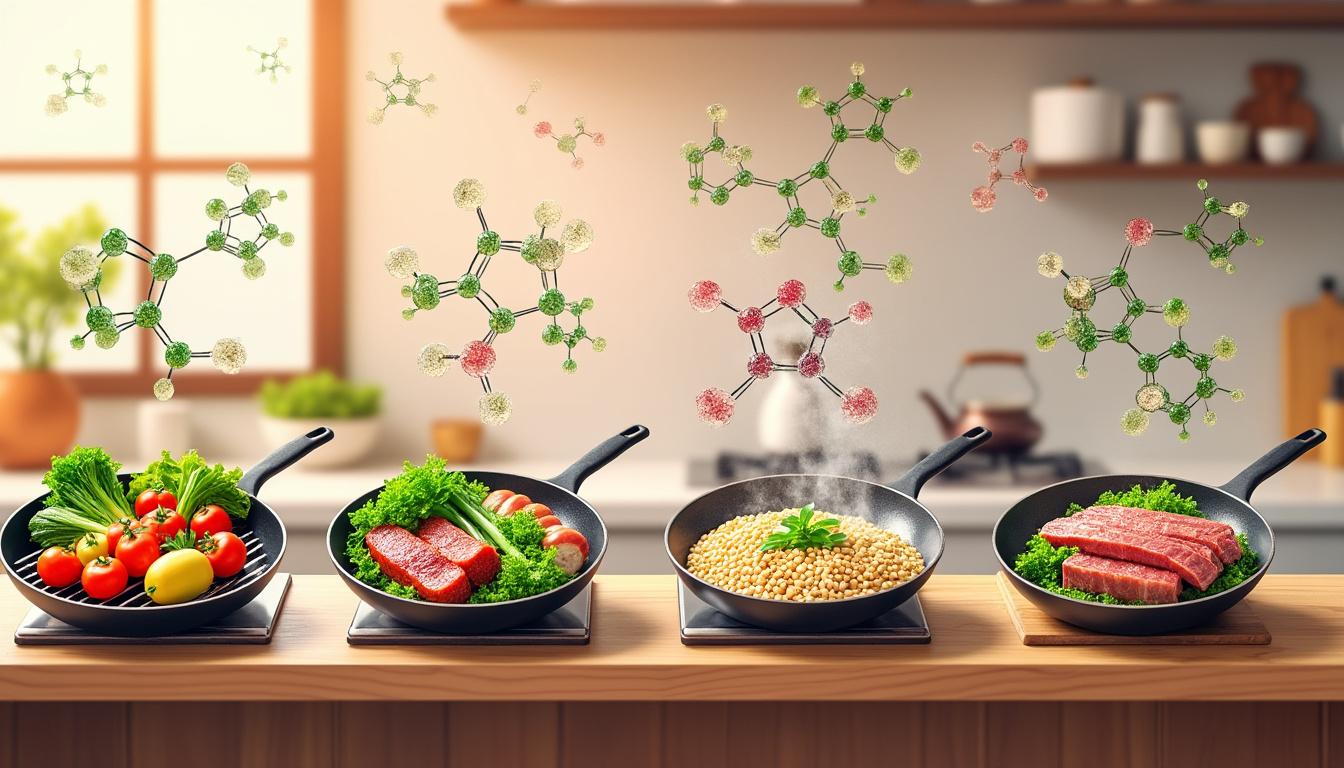Understanding the impact of cooking techniques on advanced glycation end products (AGEs) and lipid profiles offers new avenues for improving dietary health. AGEs, byproducts formed during cooking, have been implicated in various chronic diseases by promoting oxidative stress and inflammation. A recent randomized cross-over study involving healthy participants provides in-depth insights into how specific cooking methods alter the levels of AGEs and subsequently influence lipid metabolism. This knowledge is crucial for both nutritional science and culinary innovation, emphasizing healthy cooking practices that optimize food quality and support health & wellness.
How Cooking Techniques Shape Advanced Glycation End Products in Foods
Advanced glycation end products (AGEs) are generated through complex chemical reactions between sugars and proteins or lipids, particularly when foods are exposed to high heat during cooking. The Maillard reaction, responsible for the browning of food, is a primary pathway for AGE formation. Different culinary methods, such as grilling, frying, roasting, and boiling, create varying levels of AGEs based on temperature, cooking duration, and moisture content.
For instance, dry-heat cooking techniques like grilling or frying typically produce higher AGE concentrations compared to moist-heat methods such as steaming or boiling. This variance is critical considering the accumulation of dietary AGEs contributes to potential health risks including insulin resistance and cardiovascular disease. The cross-over study utilizing standardized ingredients highlighted the stark contrast in AGE content between identical foods cooked by different methods, reinforcing the importance of cooking method awareness in nutritional planning.
Examples from the study demonstrated that:
- Grilling and frying significantly elevated AGE levels, reflecting the exposure to intense, direct heat.
- Boiling and steaming yielded the lowest AGE concentrations, attributable to lower temperatures and increased moisture.
- Roasting produced intermediate AGE levels, affected by temperature control and cooking time.
This evidence highlights glycation prevention as a pivotal component of food preparation strategies. Adopting cooking methods that mitigate AGE formation aligns with nutrition awareness goals and lifestyle choices oriented towards disease prevention and optimum health.
| Cooking Method | Typical Temperature Range (°C) | Relative AGE Formation | Moisture Level |
|---|---|---|---|
| Grilling | 180-260 | High | Low |
| Frying | 160-190 | High | Low |
| Roasting | 150-220 | Moderate | Moderate |
| Boiling | 100 | Low | High |
| Steaming | 100 | Low | High |
Awareness of such variations offers practical guidance for culinary innovation focused on healthy cooking. For readers interested in enhancing their cooking skills with health in mind, resources such as Anne Burrell’s Cooking Tips provide valuable advice on technique adjustments to preserve food quality while reducing AGE content.
The Relationship Between AGEs and Lipid Profiles: Evidence from Clinical Data
Lipid profiles, encompassing cholesterol types and triglycerides, are critical indicators of cardiovascular health. The randomized cross-over study involving healthy individuals revealed that cooking-induced AGEs not only accumulate in foods but also affect serum lipid concentrations post-ingestion.
Notably, diets rich in AGEs, primarily from foods cooked at high temperatures with dry heat, were associated with:
- Elevated low-density lipoprotein (LDL) cholesterol, commonly known as ‘bad’ cholesterol.
- Reduced high-density lipoprotein (HDL) cholesterol, which plays a protective role.
- Increased triglyceride levels.
These shifts underscore the interplay between dietary AGEs and lipid metabolism, suggesting that controlling cooking practices could serve as a lifestyle choice for managing cardiovascular risk factors. The underlying mechanisms may involve AGE-induced oxidative stress and inflammatory pathways that modify lipid profiles.
For healthcare professionals and food researchers, understanding this relationship helps in designing dietary interventions targeting both glycation prevention and lipid management. Integrating this knowledge into public health guidelines could significantly improve outcomes related to chronic metabolic diseases.
| Lipid Parameter | Effect of High-AGE Diet | Effect of Low-AGE Diet | Health Implication |
|---|---|---|---|
| LDL Cholesterol | Increase | Stable or decrease | Raises cardiovascular disease risk |
| HDL Cholesterol | Decrease | Increase or stable | Protects against heart disease |
| Triglycerides | Increase | Stable or decrease | Related to metabolic syndrome |
To optimize lipid profiles through culinary choices, individuals are advised to explore cooking methods that limit AGE formation, supporting both nutrition awareness and overall health & wellness. Trusted platforms such as Anne Burrell Cooking Advice often stress the importance of such strategies in meal preparation.
Systemic and Intestinal Implications of Dietary AGEs: A Deep Profiling Approach
The recent study investigated both systemic (bloodstream) and intestinal effects resulting from the consumption of meals cooked by different methods. Ingested AGEs can accumulate not only in the circulation but also affect gut health, potentially influencing inflammatory responses and gut microbiota composition.
Key findings of this deep profiling approach included:
- Elevated markers of systemic inflammation following the intake of high-AGE meals, correlating with compromised lipid metabolism.
- Intestinal barrier function alterations, which may affect nutrient absorption and gut immunity.
- Modulation of gut microbial populations with potential downstream metabolic consequences.
These insights underscore implications for food research aimed at deciphering the complex interactions between cooking techniques, dietary components, and human physiology. Clinical evidence of such relationships encourages the development of cooking protocols prioritizing glycation prevention and gut health.
Practitioners advocating for healthy cooking can recommend foods prepared via methods proven to reduce AGEs, enhancing food quality and contributing to better lifestyle choices. For practical cooking skills aligned with these goals, readers may consult Safe Grilling Chicken & Steak Tips to balance flavor and nutritional integrity.
| Parameter | High-AGE Meal Effect | Low-AGE Meal Effect | Potential Outcome |
|---|---|---|---|
| Inflammation Markers (CRP, IL-6) | Increased | Decreased or stable | Risk of chronic conditions |
| Intestinal Barrier Integrity | Decreased | Maintained | Improved nutrient absorption |
| Gut Microbiota Diversity | Reduced | Enhanced | Better metabolic health |
Strategies for Glycation Prevention Through Culinary Innovation
Implementing targeted strategies to prevent excessive AGE formation during cooking is pivotal to improving health outcomes. Culinary innovation plays a crucial role by allowing chefs and home cooks to modify traditional recipes and methods without compromising taste or food quality.
Effective strategies include:
- Choosing moist-heat cooking methods such as steaming, poaching, or slow cooking to reduce dry heat exposure.
- Lowering cooking temperatures and shortening cooking times to mitigate AGE formation while preserving texture.
- Pre-treating foods with acidic marinades (e.g., lemon juice or vinegar) which have been shown to inhibit glycation reactions.
- Incorporating antioxidants through spices or herbs like rosemary and turmeric to counteract oxidative effects.
- Educating consumers about the influence of cooking techniques on food chemistry, fostering informed lifestyle choices.
Such approaches reflect a growing trend within health & wellness that intersects with culinary arts to promote nutrition awareness. In practice, combining safe grilling tactics with these precautions, as detailed in Safe Grilling Chicken & Steak, showcases how healthful food preparation can be both appealing and protective.
| Preventive Strategy | Description | Benefit |
|---|---|---|
| Moist-heat Cooking | Steaming, boiling | Low AGE formation, nutrient retention |
| Reduced Temperature/Time | Cooking at lower heat for shorter duration | Minimized glycation and oxidative damage |
| Acidic Marinades | Using lemon, vinegar-based marinades | Inhibition of AGE formation |
| Antioxidant Additives | Herbs, spices rich in antioxidants | Counterbalance oxidative stress |
| Consumer Education | Raising awareness on AGE and cooking | Empowered healthy food choices |
For culinary enthusiasts seeking detailed guidance on implementing these techniques, platforms like Anne Burrell Cooking Tips and Top Chef Cooking Tips offer expert advice that bridges the gap between gourmet cooking and nutritional science.
Implications for Nutrition Awareness and Lifestyle Choices in 2025
As we advance towards 2025, the intersection of food research and lifestyle choices becomes more vital for public health. This randomized study reinforces that cooking techniques extend beyond flavor and presentation, directly impacting biochemical processes relevant to chronic disease prevention.
Increasing nutrition awareness about how daily culinary decisions influence advanced glycation end products and lipid profiles empowers individuals to adopt healthier diets. Health & wellness initiatives now emphasize not only ingredient selection but also healthy cooking methods as foundational to disease mitigation.
Key lifestyle recommendations include:
- Replacing high-AGE cooking methods with gentler alternatives.
- Balancing meals with antioxidant-rich foods to mitigate oxidative stress.
- Regularly updating culinary practices in line with emerging nutritional science findings.
- Engaging with educational content such as Cooking Lessons from Ina Garten for practical healthy cooking approaches.
- Adopting safe grilling and cooking practices featured in Safe Grilling Chicken & Steak to maintain both culinary excellence and nutritional integrity.
This holistic framework integrates food quality, culinary innovation, and health & wellness, making healthier lifestyles achievable while preserving the joy of eating.
FAQ on Cooking Techniques, AGEs, and Lipid Profiles
- What are advanced glycation end products (AGEs)?
AGEs are harmful compounds formed when proteins or fats combine with sugars during high-heat cooking. They can promote inflammation and oxidative stress in the body.
- Which cooking methods produce the lowest levels of AGEs?
Moist-heat techniques like boiling and steaming generally produce the least AGEs due to lower temperatures and high moisture content.
- How do dietary AGEs affect lipid profiles?
High consumption of AGEs can increase LDL cholesterol and triglycerides, while decreasing protective HDL cholesterol, potentially raising cardiovascular risk.
- Can changing cooking methods significantly improve health outcomes?
Yes, adopting cooking techniques that minimize AGE formation can reduce inflammation and improve lipid profiles, supporting long-term health.
- Where can I learn more about healthy cooking practices?
Trusted resources include Anne Burrell’s cooking tips and Top Chef cooking tips, which offer practical guidance grounded in nutritional science.

